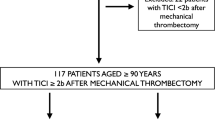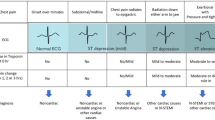Abstract
Purpose of Review
Coronary revascularization is a commonly performed major procedure in the hospitals. Stroke is one of the dreaded complications after coronary revascularization procedures. The focus of this review is to understand the stroke risk in percutaneous cutaneous intervention (PCI) and coronary artery bypass grafting (CABG) procedures.
Recent Findings
Available data show that PCI offers less procedural stroke risk compared to CABG although the survival benefits of CABG are better in certain scenarios. Innovative advancements in techniques, pre-procedural optimum medical therapy (OMT), intraoperative neuro-monitoring, and multidisciplinary post procedural care are the few strategies in early detection and reduce stroke risk.
Summary
Despite several innovations and strategies, it is evident that there is not enough data available to make concrete conclusions related to stroke risk after coronary revascularization, which warrants further investigation.
Similar content being viewed by others
References
Papers of particular interest, published recently, have been highlighted as: • Of importance •• Of major importance
Ko SB. Perioperative stroke: pathophysiology and management. Korean J Anesthesiol. 2018;71(1):3–11. https://doi.org/10.4097/kjae.2018.71.1.3.
Myint PK, Kwok CS, Roffe C, Kontopantelis E, Zaman A, Berry C, et al. Determinants and outcomes of stroke following percutaneous coronary intervention by indication. Stroke. 2016;47(6):1500–7.
Rafiq S, Johansson PI, Kofoed KF, Lund JT, Olsen PS, Bentsen S, et al. Thrombelastographic hypercoagulability and antiplatelet therapy after coronary artery bypass surgery (TEG-CABG trial): a randomized controlled trial. Platelets. 2017;28(8):786–93.
. Head SJ, Milojevic M, Daemen J, Ahn JM, Boersma E, Christiansen EH, et al. Stroke rates following surgical versus percutaneous coronary revascularization. J Am Coll Cardiol. 2018;72(4):386–98. https://doi.org/10.1016/j.jacc.2018.04.071Findings from this study suggest that stroke rates were lower in patients undergoing PCI compared with CABG, and more significantly in patients with multivessel disease and diabetes.
Gaudino M, Angiolillo DJ, Di Franco A, Capodanno D, Bakaeen F, Farkouh ME, et al. Stroke after coronary artery bypass grafting and percutaneous coronary intervention: incidence, pathogenesis, and outcomes. J Am Heart Assoc. 2019;8(13):e013032. https://doi.org/10.1161/JAHA.119.013032.
Stone GW, et al. Five-Year Outcomes after PCI or CABG for Left Main Coronary Disease. N Engl J Med. 2020;382(11):1078. https://doi.org/10.1056/NEJMx200004.
Moreyra AE, Maniatis GA, Gu H, Swerdel JN, McKinney JS, Cosgrove NM, et al. Frequency of stroke after percutaneous coronary intervention or coronary artery bypass grafting (from an eleven-year statewide analysis). Am J Cardiol. 2017;119(2):197–202. https://doi.org/10.1016/j.amjcard.2016.09.046.
Palmerini T, Biondi-Zoccai G, Riva DD, Mariani A, Savini C, Di Eusanio M, et al. Risk of stroke with percutaneous coronary intervention compared with on-pump and off-pump coronary artery bypass graft surgery: Evidence from a comprehensive network meta-analysis. Am Heart J. 2013;165(6):910–7 e14. https://doi.org/10.1016/j.ahj.2013.03.011.
Shoji S, Kohsaka S, Kumamaru H, Sawano M, Shiraishi Y, Ueda I, et al. Stroke after percutaneous coronary intervention in the era of transradial intervention. circ cardiovasc Interv. 2018;11(12):e006761. https://doi.org/10.1161/CIRCINTERVENTIONS.118.006761.
Jansen Klomp WW, Brandon Bravo Bruinsma GJ, van’t Hof AW, Grandjean JG, Nierich AP. Imaging techniques for diagnosis of thoracic aortic atherosclerosis. Int J Vasc Med. 2016;2016:4726094. https://doi.org/10.1155/2016/4726094.
Ikram A, Mohiuddin H, Zia A, Siddiqui HU, Javadikasgari H, Koprivanac M, et al. Does epiaortic ultrasound screening reduce perioperative stroke in patients undergoing coronary surgery? A topical review. J Clin Neurosci. 2018;50:30–4. https://doi.org/10.1016/j.jocn.2018.01.003.
Andersen ND, Hart SA, Devendra GP, Kim ESH, Johnston DR, Schroder JN, et al. Atheromatous disease of the aorta and perioperative stroke. J Thorac Cardiovasc Surg. 2018;155(2):508–16. https://doi.org/10.1016/j.jtcvs.2017.08.132.
Grossi EA, Bizekis CS, Sharony R, Saunders PC, Galloway AC, Lapietra A, et al. Routine intraoperative transesophageal echocardiography identifies patients with atheromatous aortas: impact on “off-pump” coronary artery bypass and perioperative stroke. J Am Soc Echocardiogr. 2003;16(7):751–5. https://doi.org/10.1016/S0894-7317(03)00284-0.
Patil TA, Nierich A. Transesophageal echocardiography evaluation of the thoracic aorta. Ann Card Anaesth. 2016;19:S44–55. https://doi.org/10.4103/0971-9784.192623.
Wilson JM. Coronary artery bypass surgery and percutaneous coronary revascularization: impact on morbidity and mortality in patients with coronary artery disease. Coron Artery Dis. 2015;1:683–726.
Mehta A, Choxi R, Gleason T, Wechsler L, Jovin T, Thirumala PD. Carotid artery disease as a predictor of in-hospital postoperative stroke after coronary artery bypass grafting from 1999 to 2011. J Cardiothorac Vasc Anesth. 2018;32(4):1587–96. https://doi.org/10.1053/j.jvca.2017.10.010.
Patel BM, Reinert NJ, Al-Robaidi K, Gao X, Fabio A, Esper SA, et al. Independent predictors of perioperative stroke-related mortality after cardiac surgery. J Stroke Cerebrovasc Dis. 2020;29(5):104711. https://doi.org/10.1016/j.jstrokecerebrovasdis.2020.104711.
Tzoumas A, Giannopoulos S, Texakalidis P, Charisis N, Machinis T, Koullias GJ. Synchronous versus staged carotid endarterectomy and coronary artery bypass graft for patients with concomitant severe coronary and carotid artery stenosis: a systematic review and meta-analysis. Ann Vasc Surg. 2020;63:427–38 e1. https://doi.org/10.1016/j.avsg.2019.09.007.
Giannopoulos S, Texakalidis P, Charisis N, Jonnalagadda AK, Chaitidis N, Giannopoulos S, et al. Synchronous carotid endarterectomy and coronary artery bypass graft versus staged carotid artery stenting and coronary artery bypass graft for patients with concomitant severe coronary and carotid stenosis: a systematic review and meta-analysis. Ann Vasc Surg. 2020;62:463–73 e4. https://doi.org/10.1016/j.avsg.2019.06.018.
Wang LJ, Ergul EA, Mohebali J, Goodney PP, Patel VI, Conrad MF, et al. The effect of combining coronary bypass with carotid endarterectomy in patients with unrevascularized severe coronary disease. J Vasc Surg. 2019;70(3):815–23. https://doi.org/10.1016/j.jvs.2018.12.026.
Paraskevas KI, Nduwayo S, Saratzis AN, Naylor AR. Carotid stenting prior to coronary bypass surgery: an updated systematic review and meta-analysis. Eur J Vasc Endovasc Surg. 2017;53(3):309–19. https://doi.org/10.1016/j.ejvs.2016.12.019.
Wesselink E, Kappen T, Torn H, Slooter A, Van Klei W. Intraoperative hypotension and the risk of postoperative adverse outcomes: a systematic review. British J Anaesthesia. 2018;121(4):706–21.
Defining an Intraoperative Hypotension Threshold in Association with Stroke in Cardiac Surgery: Erratum. Anesthesiology. 2019;130(2):360. https://doi.org/10.1097/ALN.0000000000002496.
Sun LY, Chung AM, Farkouh ME, van Diepen S, Weinberger J, Bourke M, et al. Defining an intraoperative hypotension threshold in association with stroke in cardiac surgery. Anesthesiology. 2018;129(3):440–7. https://doi.org/10.1097/ALN.0000000000002298.
Hori D, Brown C, Ono M, Rappold T, Sieber F, Gottschalk A, et al. Arterial pressure above the upper cerebral autoregulation limit during cardiopulmonary bypass is associated with postoperative delirium. Br J Anaesth. 2014;113(6):1009–17. https://doi.org/10.1093/bja/aeu319.
Bockeria OL, Shvartz VA, Akhobekov AA, Kiselev AR, Prokhorov MD, Golukhova EZ, et al. Statin therapy in the primary prevention of early atrial fibrillation after coronary artery bypass grafting. Indian Heart J. 2016;68(6):792–7. https://doi.org/10.1016/j.ihj.2016.04.002.
Hussain MA, Saposnik G, Raju S, Salata K, Mamdani M, Tu JV, et al. Association between statin use and cardiovascular events after carotid artery revascularization. J Am Heart Assoc. 2018;7(16):e009745.
Iqbal J, Zhang YJ, Holmes DR, Morice MC, Mack MJ, Kappetein AP, et al. Optimal medical therapy improves clinical outcomes in patients undergoing revascularization with percutaneous coronary intervention or coronary artery bypass grafting: insights from the Synergy Between Percutaneous Coronary Intervention with TAXUS and Cardiac Surgery (SYNTAX) trial at the 5-year follow-up. Circulation. 2015;131(14):1269–77. https://doi.org/10.1161/CIRCULATIONAHA.114.013042.
Cardoso R, Knijnik L, Whelton SP, Rivera M, Gluckman TJ, Metkus TS, et al. Dual versus single antiplatelet therapy after coronary artery bypass graft surgery: an updated meta-analysis. Int J Cardiol. 2018;269:80–8. https://doi.org/10.1016/j.ijcard.2018.07.083.
Stringberg A, Camden R, Qualls K, Naqvi SH. Update on dual antiplatelet therapy for secondary stroke prevention. Mo Med. 2019;116(4):303–7.
Firstenberg MS, Dyke CM, Angiolillo DJ, Ramaiahm C, Price M, Brtko M, et al. Safety and efficacy of cangrelor, an intravenous, short-acting platelet inhibitor in patients requiring coronary artery bypass surgery. Heart Surg Forum. 2013;16(2):E60–9. https://doi.org/10.1532/HSF98.20121103.
Bhattad VB, Gaddam S, Lassiter MA, Jagadish PS, Ardeshna D, Cave B, et al. Intravenous cangrelor as a peri-procedural bridge with applied uses in ischemic events. Ann Transl Med. 2019;7(17):408. https://doi.org/10.21037/atm.2019.07.64.
Kashani HH, Mosienko L, Grocott BB, Glezerson BA, Grocott HP. Postcardiac surgery acute stroke therapies: a systematic review. J Cardiothorac Vasc Anesth. 2020;34(9):2349–54. https://doi.org/10.1053/j.jvca.2020.03.041.
Haider AS, Garg P, Watson IT, Leonard D, Khan U, Haque A, et al. Mechanical thrombectomy for acute ischemic stroke after cardiac surgery. Cureus. 2017;9:4.
Domenick Sridharan N, Thirumala P, Chaer R, Balzer J, Long B, Crammond D, et al. Predictors of cross-clamp-induced intraoperative monitoring changes during carotid endarterectomy using both electroencephalography and somatosensory evoked potentials. J Vasc Surg. 2018;67(1):191–8. https://doi.org/10.1016/j.jvs.2017.04.064.
Yun WS. Cerebral monitoring during carotid endarterectomy by transcranial Doppler ultrasonography. Ann Surg Treat Res. 2017;92(2):105–9. https://doi.org/10.4174/astr.2017.92.2.105.
Gorenek B, Parspur A, Timuralp B, Birdane A, Ata N, Cavusoglu Y, et al. Atrial fibrillation after percutaneous coronary intervention: Predictive importance of clinical, angiographic features and P-wave dispersion. Cardiology. 2007;107(3):203–8.
Ma WQ, Sun XJ, Wang Y, Han XQ, Zhu Y, Liu NF. Does body mass index truly affect mortality and cardiovascular outcomes in patients after coronary revascularization with percutaneous coronary intervention or coronary artery bypass graft? A systematic review and network meta-analysis. Obes Rev. 2018;19(9):1236–47.
Liu Z, Sanossian N, Starkman S, Hamilton S, Avila-Rinek G, Liebeskind D, et al. The obesity paradox characterizes outcome from acute ischemic stroke: evidence from 1033 patients (P3. 3-031). AAN Enterprises; 2019.
Pierpont YN, Dinh TP, Salas RE, Johnson EL, Wright TG, Robson MC, et al. Obesity and surgical wound healing: a current review. ISRN Obes. 2014;2014:638936–13. https://doi.org/10.1155/2014/638936.
Croke LM. Dual antiplatelet therapy for high-risk TIA and minor stroke: BMJ rapid recommendation. Am Fam Physician. 2019;100(6):378–9.
Zanatta P, Benvenuti SM, Bosco E, Baldanzi F, Palomba D, Valfrè C. Multimodal brain monitoring reduces major neurologic complications in cardiac surgery. J Cardiothor Vasc Anesthesia. 2011;25(6):1076–85.
. Grant MC, Isada T, Ruzankin P, Whitman G, Lawton JS, Dodd-o J, et al. Results from an enhanced recovery program for cardiac surgery. J Thorac Cardiovasc Surg. 2020;159(4):1393–402.e7 This study emphasizes on phase-specific enhanced recovery programs guidelines for better outcomes in patients post cardiac surgery.
Padmanabhan H, Brookes MJ, Nevill AM, Luckraz H. Association between anemia and blood transfusion with long-term mortality after cardiac surgery. Ann Thorac Surg. 2019;108(3):687–92. https://doi.org/10.1016/j.athoracsur.2019.04.044.
Author information
Authors and Affiliations
Corresponding author
Ethics declarations
Conflict of Interest
Salvador Cruz-Flores reports personal fees from Novo Nordisk, Galapagos, and Sunovion. The other authors declare that they have no conflict of interest.
Human and Animal Rights and Informed Consent
This article does not contain any studies with human or animal subjects performed by any of the authors.
Additional information
Publisher’s Note
Springer Nature remains neutral with regard to jurisdictional claims in published maps and institutional affiliations.
This article is part of the Topical Collection on Ischemic Heart Disease
Rights and permissions
About this article
Cite this article
Kandimalla, J., Hussain, Z., Piriyawat, P. et al. Stroke Rates Following Surgical Versus Percutaneous Revascularization for Ischemic Heart Disease. Curr Cardiol Rep 23, 45 (2021). https://doi.org/10.1007/s11886-021-01471-w
Accepted:
Published:
DOI: https://doi.org/10.1007/s11886-021-01471-w




